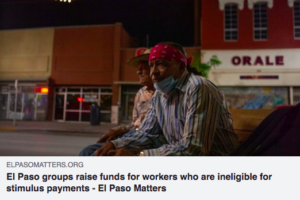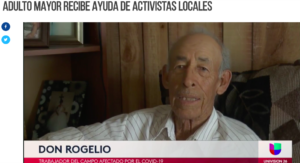In El Paso, residents aren’t waiting for Congress to fix immigration
Grassroots efforts to improve relations between border officials and local community hold important lessons for reform
EL PASO, Texas — As 2013 drew to a close, volunteers for the Border Network for Human Rights (BNHR) fanned out into El Paso and the surrounding communities to collect stories of abuse and mistreatment by law enforcement officials. The annual effort seeks to establish accountability for officers working along the El Paso sector of the U.S.-Mexico border.
Amid the steady stream of complaints that rolled in, Fernando Garcia, the organization’s director, noticed a conspicuous absence of grievances against Customs and Border Protection (CBP) and the El Paso County Sheriff’s Department. “I said, ‘This cannot be,”’ recalled Garcia. He extended the campaign for two weeks and told volunteers to focus on finding any potential complaints against Border Patrol, an arm of CBP. But once again, volunteers found no verifiable incidents of abuse.
For El Paso, this seemingly small development carried big implications. The findings are one of many signs that indicate years’ worth of grassroots efforts to create greater oversight of law enforcement here may be paying off. Although many border experts say it’s premature to call the Texas city a success story, activists and U.S. authorities in El Paso may be learning lessons that can help reduce friction in other towns throughout the southern border region.
“People aren’t walking around in fear in downtown El Paso or on the outskirts,” said El Paso County Judge Veronica Escobar. “They don’t feel that they’re going to be chased down by Border Patrol agents or local sheriff officers. That’s enormous that people feel safe in their community and people feel that they’re not afraid of law enforcement.”
To explain how far El Paso has come, Escobar recalled when she first began working on immigration and border issues in the 1990s. At the time, border enforcement agents had taken a much more aggressive stance, engaging in controversial practices like going undercover at local high schools to check students’ immigration status.
Among the residents of El Paso, there was sometimes outright hostility toward those who challenged immigration policies. It wasn’t uncommon for passersby to shout insults if they recognized Escobar as an activist.
The distrust worked both ways. “Most of the organizations at that time that worked at the border — and some of them still — they saw the Border Patrol as the problem, and the only solution was for the Border Patrol to disappear,” said Garcia. “Back then, if you talked to Border Patrol, you would be seen as a sellout.”
That’s the bottom line. It’s the openness. If they call to ask, answer. Don’t hide behind your authority to not answer.-Ramiro Cordero, Customs and Border Protection
Meanwhile, Garcia said, even if he and his cohorts wanted to talk to law enforcement officials, they had difficulty getting their attention. Organizations like CBP saw them as activists pushing an agenda, he said.
For both sides, a turning point came when BNHR issued its first report methodically documenting law enforcement abuses, rather than relying on sporadic, anecdotal accounts. The report made headlines and brought both CBP and BNHR to the table. More than 10 years later, there’s an acknowledgment from both groups that progress depends on maintaining clear channels of communication.
Now CBP maintains a nonuniformed community liaison in El Paso and regularly invites community members to participate in various CBP events and to speak with Border Patrol agents.
“Once you’re able to open their eyes a little, then you’re able to go in there with the education part and be open about what we do,” said Ramiro Cordero, special operations supervisor for CBP in El Paso. “That’s the bottom line. It’s the openness. If they call to ask, answer. Don’t hide behind your authority to not answer.”
Additionally, El Paso’s sheriff, Richard Wiles, has adopted a policy of not enforcing immigration law, unless it’s relevant to the department’s mandate to protect state and local laws.
“Immigration is solely a federal responsibility, and I do not work with them on those issues,” said Wiles. If he had to enforce immigration issues, he explained, “I’m pulling away officers from being in the community because they have to work on this immigration thing they just ran across.”
For residents of El Paso, the gradual improvement has come as a welcome development. About 10 years ago, Eddie Torres said, authorities used to pull people over for what seemed like relatively arbitrary or minor infractions. Torres, who runs a print shop, said it seemed to him that officials were looking for an excuse to check people’s papers.
“For a while it got a bit out of hand,” he said. While there have been improvements, he said he still often faces rude and unwelcome behavior from CBP officials when crossing the border to visit his family members in Ciudad Juarez.
Ernesto Cabral, a full-time cyclist who splits his time between Ciudad Juarez and El Paso, said that for the most part he’s pleased with how authorities conduct themselves in El Paso. With tattoos covering most of his right arm, he said that on several occasions he’s experienced unwanted attention from police.
“It’s not problems with the departments. It’s the problems with the city,” he said, explaining that in a border town like El Paso, authorities are bound to be more cautious. As long as tensions don’t affect relations between El Paso and Ciudad Juarez, he said, he doesn’t have a problem with how authorities conduct themselves here.
You can be part of the problem, or you can be part of the solution. Today the border is standing up to be part of the solution. -Rep. Beto O’Rourke
El Paso and border enforcement agencies have effectively adopted a basic community-policing model that connects officers and community members. Simple as that may sound, as abuses mount along the southern border, maintaining such a program may be easier said than done.
“The problems with CBP are systemic, and I don’t think I would be singing the praises for the El Paso sector just yet,” said Vicki Gaubeca, director of the American Civil Liberties Union’s Regional Center for Border Rights in Las Cruces, N.M.
A New Mexico woman recently filed a lawsuit after she experienced a six-hour search trying to cross legally from Ciudad Juarez into El Paso. The search, which included anal and vaginal probes, found no drugs.
Nationally, of those who come into contact with CBP, 11 percent report experiencing varying degrees of physical abuse and 23 percent say they received verbal abuse, according to a recentreport by the Immigration Policy Center.
Far from being isolated incidents, the report’s authors argued, the mistreatment they recorded corresponds to a well-documented pattern of behavior. Of deportees interviewed for a 2011 report by the humanitarian border organization No More Deaths, 10 percent said U.S. authorities physically abused them. A separate report looking at Salvadorans deported between 1999 and 2000 found that 16 percent experienced physical abuse.
“These consistent results across multiple studies suggest that abuse of migrants while in U.S. custody is a systematic problem relating to an ongoing institutional culture rather than simply a consequence of a few people who are acting inappropriately,” stated the Immigration Policy Center report.
Later this month, two local congressmen plan to introduce a bill to the U.S. House of Representatives that would install more oversight and accountability measures on border enforcement agencies. Although Congress seems unlikely to take up a comprehensive immigration bill this year, the bipartisan duo behind the bill, Rep. Steve Pearce, R-N.M., and Rep. Beto O’Rourke, D-Texas, say they hope bills like theirs can begin addressing the issue through a piecemeal approach.
“In many ways, we feel as though our civil rights, our civil liberties and our constitutional guarantees are suspended here on the border,” O’Rourke told reporters after unveiling the bill to his constituents at an event last weekend. “You can be part of the problem, or you can be part of the solution. Today the border is standing up to be part of the solution.”
The proposed legislation has received much praise among those in the border region, but even with its initial bipartisan support, many question whether it can pass through a chronically gridlocked U.S. Congress. Amid this climate, many see the grassroots approach that has worked in El Paso as the best option for immediate results.
“We’ve been waiting for comprehensive immigration reform for many years, and it looks like it’s going to drag out some more,” says Texas state Sen. Jose Rodriguez, who represents El Paso. “In the meantime, I don’t think that communities should just be dependent on some reform passing sometime in the future.
“Communities can take these issues into their own hands and deal with the local law enforcement agencies, as well as the federal agencies at the local level, to establish better lines of communications, protocols for reviewing complaints that are filed against the law enforcement community. Those things can be done even without comprehensive immigration reform.”
Reported from El Paso,Texas, with the support of the Robert Novak Journalism Fellowship.




